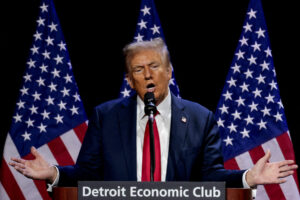Understanding Market Reactions to Political Policies: Insights from the S&P 500’s Performance
Following the dramatic events surrounding Election Day this past November, the S&P 500 (^GSPC) experienced an impressive uptick of 5.3% in its first month, largely fueled by optimism regarding incoming President Donald Trump. Promises of aggressive fiscal stimulus, tax cuts, and business-friendly deregulation sparked excitement among investors, with many anticipating a robust environment for corporate profits.
However, this initial euphoria was short-lived. By December 6, the index reported a 4% decline, as apprehensions grew over Trump’s "America First" agenda. Many investors began worrying about potential tariffs that could drive up import costs, along with immigration policies that might increase labor costs due to the deportation of migrant workers. This renewed anxiety has led to concerns about a resurgence of inflation right when it seemed to be waning after peaking in 2022.
Implications of Policy Uncertainty on Markets
Markets have historically reacted negatively to uncertainty, an issue that has become prevalent in the current political climate. The uncertain policy landscape under Trump has led to market volatility as investors grapple with the implications of his administration’s decisions. As of November, the economic uncertainty index, maintained by economists Scott Baker, Nicholas Bloom, and Steven Davis, skyrocketed from 109 in October to a staggering 225 in November—the highest level since 2022, only slightly retracing to 215 in December.
Tom Lee, from Fundstrat, emphasized the turbulence of 2025 in light of these policy uncertainties, notably including anticipated tariffs and immigration changes. Such unpredictability has led to a cautious outlook from various quarters, including the Federal Reserve, whose December meeting minutes indicated a heightened concern over the potential economic impacts of Trump’s policies on foreign trade and immigration.
Investor Sentiment and Rising Inflation Concerns
Markets are currently reflecting one main concern: the potential rise in inflation driven by tariffs. A recent survey by the University of Michigan illustrated that consumer expectations for future inflation have significantly increased, raising alarm bells about the possible stagflationary consequences of Trump’s policy initiatives. Analysts at Capital Economics noted that consumers are becoming increasingly anxious about these implications.
This anxiety is palpable among investors, as highlighted by unusual fluctuations in interest rates. Since September, while the Federal Reserve has cut short-term interest rates by a full percentage point, the rate on the 10-year Treasury bond has paradoxically increased by over a full percentage point—a deviation not commonly seen under such circumstances. According to Moody’s Analytics, markets appear to be adjusting to a future characterized by increased volatility and inflation.
Navigating Potential Rate Hikes and Market Adjustments
As inflation resurfaces, the Fed’s ability to maneuver becomes not only critical but complicated. Should inflation rise sharply, the central bank may find itself compelled to reverse the recent cycle of rate cuts. This concern has led to heightened expectations for interest rate hikes, particularly following the strong jobs report from December, which indicated a robust economy unlikely to necessitate further rate cuts.
Higher interest rates typically translate to a more complex landscape for stocks. Increased fixed-income rates make bonds more appealing to investors, prompting some to divest from stocks. Additionally, elevated borrowing costs can erode profitability for businesses, influencing stock valuations negatively.
Looking Ahead: The Trump Administration’s Next Moves
As Trump takes office, how he navigates issues such as tariffs and immigration will be crucial in shaping both market sentiment and economic stability. If he can indicate potential flexibility regarding tariffs and contain reparative actions around immigration to specific groups, the climate for investors could improve markedly. Many remain hopeful, predicting that the threats posed by Trump’s administration may ultimately prove more alarming than the reality.
Nevertheless, the path forward is fraught with uncertainty. Investors are keenly aware that any inflationary spikes must be vigilantly avoided, and they are closely monitoring signals from the new administration. While markets may tolerate a certain level of ambiguity, their patience will undoubtedly wear thin if inflation concerns escalate.
Ultimately, the ongoing narrative surrounding Trump’s policies will define the trajectory of financial markets in 2025 and beyond. Investors must stay informed and adaptive, monitoring not just stock performance but also broader economic indicators that could signal shifts in the marketplace.
Stay Updated with Extreme Investor Network
As developments unfold, it’s essential to keep a pulse on the intersection of politics and finance. To stay informed about how policies may shape market performance and investment opportunities, make sure to follow updates and analyses from Extreme Investor Network. Our insights are designed to empower you to make strategic investment decisions amidst uncertainty.

